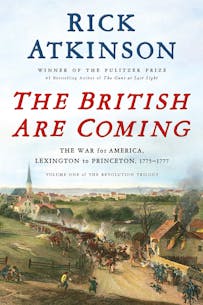Read the Revolution
The British Are Coming
December 22, 2021
Purchase the New York Times-bestselling book from Macmillan Publishers.
At the Battle of Trenton, General George Washington’s army defeated a force of Hessian troops, German soldiers who fought alongside the British in America. Included among the 900 captured Hessians was a group of oboists (“hautboists”), the favorite entertainment of Colonel Johann Rall, who was described by fellow officers as “an exceptional friend of music” before he was mortally wounded in Trenton, New Jersey, on Dec. 26, 1776. In The British Are Coming: The War for America, Lexington to Princeton, 1775-1777, bestselling author Rick Atkinson characterizes Rall and the formidable forces at Trenton in 1777 in context with military affairs starting with the battles at Lexington and Concord in 1775. As Atkinson’s first volume in the Revolution Trilogy, he presents the first 21 months of the Revolutionary War with insights on British planning from the British perspective.
Read two excerpts from Chapter 21: The Smiles of Providence, about Colonel Johann Rall’s military leadership and what happened to the three Hessian regiments, stationed at Trenton.
Excerpt 1
Six brass 3-pounders squatted in a neat row outside a guardhouse in the village center, close to the barn where Hessian artillery horses stood harnessed in their stalls, ready for battle at a moment’s notice. As shadows lengthened and the holy night drew near, troops from the duty regiment swung up King Street for the usual changing of the guard at two p.m. A military band circled the brick St. Michael’s Anglican Church “like a Roman Catholic procession, wanting only the cross and the banner and the chanting choristers,” Lieutenant Andreas Wiederholdt told his diary. The music often lured the garrison commander from his headquarters in the large frame house west of the street. The reedy sound of hautboys particularly charmed him. As Wiederholdt observed, “He never could have enough of them.”
Colonel Johann Gottlieb Rall had spent thirty-six of his fifty years in uniform, fighting in Bavaria, on the Rhine, and in Holland. As a soldier of fortune, he had also fought in Turkey and in Russia under Aleksey Grigoryevich Orlov, the reputed killer of Czar Peter III, whose death brought Catherine the Great to the throne. Rall would be caricatured as a drunkard, a martinet, a sybarite, and a military mooncalf, none of which was true. If rough-hewn, he was respected as “a born soldier,” in one comrade’s estimation, and as a combat leader. His ferocity at White Plains and Fort Washington reportedly earned him the nickname der Löwe, the lion. Rall’s adjutant, Lieutenant Jakob Piel, described him as “generous, magnanimous, hospitable, and polite to everyone,” even if at times “a thought came to him, then another, so that he could not settle on a firm decision.” Although Rall spoke neither English nor French, General Howe considered him capable enough to command not only his own regiment but the entire brigade posted at Trenton. Rall’s leadership was needed, for the German senior ranks had thinned: one colonel had died of dysentery, another was convalescing from battle wounds, and three generals were hors de combat with various afflictions.
As he settled into his new command at Trenton, Rall alternated between bluster and nervous anxiety. He considered American soldiers “nothing but a lot of farmers.” When a major asked him to order shoes from New York for the ranks, he promised to “lead the brigade in bare feet over the ice to Philadelphia.”
Sign Up
Get biweekly Read the Revolution featured excerpts right to your inbox.
Excerpt 2
Colonel Rall, der Löwe, had passed Christmas evening playing checkers in the King Street house where he made his headquarters. The command post was comfortable enough — three sitting rooms with fireplaces on the first floor, a dining room with two hearths, five chambers on the second floor, and a pump by the door. But Rall’s quiet game had been interrupted at eight p.m. by rebel raiders — acting without Washington’s knowledge — who wounded half a dozen Hessian troopers outside Trenton. When the hubbub subsided, Rall ate supper at a neighbor’s, played cards until midnight, and went to bed.
The early morning clamor at both ends of Trenton failed to wake him, and only after a frantic summons from Lieutenant Piel, his adjutant, did Rall appear at a window in his nightshirt. After ducking back inside, he soon reappeared in uniform on King Street to find that the village had become a battlefield. American soldiers rampaged through lanes and gardens, breaking down doors, raking upper windows with musket fire, and trading shots with Hessians crouched behind the gravestones in St . Michael’s churchyard. A rebel darted forward, stooped over the body of an enemy officer shot dead in a doorway, then pulled off his boots and scurried away.
[...]
Mounting his horse, Rall herded two of his infantry regiments behind St. Michael’s to regroup while trying to gauge the size of the American assault. Shouting, “Advance! Advance!” above the clangor, he then led the troops in quickstep across Queen Street to an apple orchard, determined to counterattack Greene’s division from the east. This scheme proved bootless. From his vantage at the top of the town, Washington tracked the Hessian movement and ordered a blocking force of riflemen across the Princeton road on the American left flank. Faced with murderous artillery and small arms fire from superior ground, Rall wheeled his brigade back into the center of the village, colors flying. “From their motions,” Washington later told Hancock, “they seemed undetermined how to act.” Sleet, rain, and snow seemed to whip simultaneously through streets now banked in white smoke. Hessian musicians pounded drums and tootled a few uncertain bars on their hautboys. As Rall’s infantry poured back into King Street, they recovered the two fieldpieces lost earlier, much to Knox’s annoyance.
[...]
In half a morning, Howe had lost almost a thousand of his fourteen thousand men in New Jersey. Casualty estimates would vary, but the king’s losses apparently included twenty-two Hessians killed, eighty-three badly wounded, and about nine hundred captured. “Saw a room full of wounded Hessians, one of them with his nose shot off,” militia sergeant William Young wrote in his journal. “All of them are in a wretched condition.” An American medical officer wrote another physician that five gravely injured enemy soldiers needed shattered limbs removed but “the amputating instruments which you sent for use of the Hessian surgeon … were so bad that he could not make use of them.” Some men were beyond surgery. Colonel Rall was carried from the Methodist church to his King Street headquarters, which now stood riddled with shot and shell. Washington and Greene briefly visited him to grant parole so that he did not have to be moved again; Rall asked through an interpreter that his men be treated well. He died in agony on Friday evening, “satisfied that it was not necessary for him to outlive his honor,” Lieutenant Piel told his diary. “Colonel Rall was truly born to be a soldier, but not a general.” He was buried in the Presbyterian yard on Second Street.
Among those who escaped were the only British soldiers in Trenton on Christmas—twenty troopers from the 16th Light Dragoons who had galloped over the Assunpink bridge at the first sound of trouble. Before the bridge was sealed, at least four hundred and perhaps more than six hundred Germans had also eluded capture —musicians, drummers, doctors, camp followers, rank-and-file skedaddlers— who exploited the failure of Colonel Cadwalader and others to seal off the village from the south. Some would be found in various barns and attics, like the two fugitives rousted from a stable by a snarling dog and a farmer’s pitchfork. Scouts soon reported that Colonel Donop was so unnerved by the news from Trenton that he abandoned both his comely widow and his casualties in Mount Holly to lead his brigade—including 150 carts and carriages laden with plunder—on a forced march to Princeton. Jäger flanked “both sides of the column to prod the drivers on with blows,” according to Captain Ewald.
With thousands of enemies less than a day’s march away, Washington decided to collect his winnings and return promptly to Pennsylvania. Although his own battle casualties were minor—a dozen killed or wounded—hundreds more suffered from exhaustion, sickness, and cold weather injuries, including frostbite. “I was extremely chilled,” a chaplain wrote in his journal, “and came near perishing before I could get to a fire.” Many warmed themselves with some of the forty hogsheads of enemy rum discovered in Trenton before Washington could destroy the stocks; other troops reportedly found whiskey and sugar in a cellar, stirred them together with a fence rail in a rain barrel, and used their shoes for tankards. By midafternoon on Thursday, ferrymen began shifting the spoils of war westbound across the Delaware: wagons, brass guns, forty horses, a thousand stand of small arms, a dozen drums, a number of hautboys, and several sets of regimental colors, including a white damask silk square depicting an eagle and the motto Pro Principe et Patria stitched in gold.
Rick Atkinson, The British Are Coming: The War for America, Lexington to Princeton, 1775-1777, The Revolution Trilogy – Volume 1 (Holt Paperbacks, 2020).
Read the Revolution is sponsored by The Haverford Trust Company.
Read the Revolution is published biweekly by the Museum of the American Revolution to inspire learning about the history of the American Revolution and its ongoing relevance.

